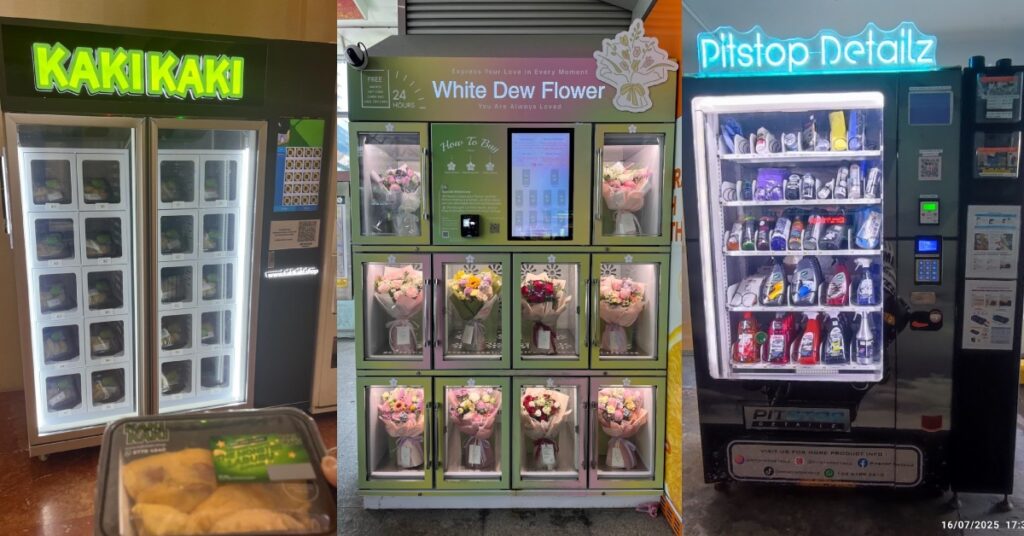
You can find almost anything in vending machines these days—gourmet coffee, fresh salads, tech gadgets, and even medicines.
These machines have clearly evolved beyond offering just convenience items. You could even think of them as micro-retail hubs, small, automated storefronts that bring a wide range of products directly to consumers.
And they’re everywhere. You can spot them in malls, office buildings, and even tucked right outside your HDB block. In fact, statistics reported by CNA show that vending machine sales in Singapore went up for four consecutive years between 2020 and 2024, from S$85.7 million to S$116.8 million.
But what exactly makes a vending machine business so appealing, and why are they multiplying in Singapore?
Saving on rent, staff & more
Running a business in Singapore is no walk in the park. The challenges of maintaining a physical storefront are well-known: sky-high rental rates that show no sign of easing, stiff competition, and the constant pressure to innovate.
These hurdles have only become more pronounced post-COVID, driven by shifting consumer behaviours and economic headwinds. Business closures are rampant—in fact, Singapore saw a surge in business liquidations in the first half of 2025, hitting a five-year high.
The churn has been especially relentless in the F&B industry, which saw record closures last year with over 3,000 outlets shutting down, the highest in two decades. This year, between Jan and Oct 2025, 2,431 F&B establishments shuttered, and 63% of those had only been operating for five years or less. Even more strikingly, 82% of these had never made a profit, highlighting just how difficult it is to build a sustainable business here.
So, it’s no surprise that more businesses are turning to vending machines—you don’t need to pay those sky-high rents, you don’t need full-time staff, and overhead costs are massively reduced.
Several operators surveyed by CNA noted that the monthly cost of renting the smaller space required for a vending machine can range from S$300 to S$800 in shopping centres, and S$600 to S$1,100 at bus and train stations.

This is exactly why Kaki Kaki, a Singapore durian seller that operates seven durian vending machines, finds the model attractive. The business said that rent is “significantly” more affordable than renting a stall, allowing cost savings to be passed onto consumers while doubling down on quality.
“The more we save, the more we are able to purchase better quality durians and pass on the savings to the consumer.”
Online retailers are also adopting vending machines to boost sales and market themselves in Singapore—without the financial burden of operating a full store.
Kegan Tan, the director of Spartan Sports, which sells sporting goods online, explained to The Straits Times that vending machines are a “relatively low-cost way” for online businesses to establish a physical presence.

“Vending machines became a way for us to create an offline presence that generates traffic to our online store and e-commerce platform pages,” Kegan said. At the end of 2024, he owned three machines, which he rotated among malls, bus stops, and residential areas.
For these online businesses, vending machines also improve operational efficiency. Automotive care product retailer Pitstop Detailz, which previously sold its products through Carousell, now operates five vending machines in carparks across Singapore. The machines have significantly reduced the time spent packing and shipping orders, allowing the business to focus on growth and customer engagement.
But it isn’t so simple to implement
Given how it’s benefitted these businesses, vending machines might seem like a no-brainer—even an idle way to earn money. Just get a machine, plonk it somewhere visible, fill it with products people need or might want, and watch the money roll in, right?
But the reality of running a vending machine isn’t nearly as passive as it sounds. Inventory management, maintenance, restocking, payment system monitoring, and location strategy all demand time, effort, and careful planning.

Take hot meal vending brand Chef-in-Box, for instance. When they first launched, no vending machine had successfully delivered hot meals to consumers without human involvement. Traditional machines also couldn’t track stock or troubleshoot issues remotely, a limitation that often led to significant food wastage at low-traffic locations.
To overcome this, Chef-in-Box invested heavily in systems that collect and analyse data from every machine, tracking consumption patterns, customer preferences, and peak hours.
On top of this, to maintain hygiene and freshness, they also needed to invest time and resources into frequent cleaning, sanitisation, and careful temperature monitoring. All of their machines are cleaned and sanitised daily, while built-in sensors monitor temperature and stock.
Similarly, InstaChef operates under a comparable model, with frequent restocking, rigorous cleaning schedules, and AI-enabled monitoring to ensure meals are safe, fresh, and consistently available.
Even if your vending machines don’t dispense hot meals or perishable goods, there are still numerous operational considerations that can quickly add up in costs. SingSaver estimates machine maintenance to start from S$100 per session, while transport and labour for restocking can run S$30 to S$50 per round.
Vending machine operators also need insurance as there are risks that could cause financial loss or liability issues—and according to the publication, you’ll have to spend at least S$600 per year for commercial coverage.

Sales are not guaranteed, too. For White Dew Flower, a florist that operates several vending machines across Singapore, the main challenge it faced was growing its business.
Sales performance differs from location to location, and there is also a “lack of available space” for flower vending machines in shopping malls, where footfall is generally higher.
“Most malls already have a flower shop and those without one do not have designated spaces for vending machines,” Perry Peng, the business’s founder, told CNA.
A lucrative option despite increasing competition
That said, vending machines still offer a potentially lucrative business model. If rent and manpower costs continue to pose major hurdles for businesses setting up shop, industry players believe the vending machine boom may well continue.
But with more players entering the scene, competition for space is intensifying—and that brings its own challenges.
Full-service vending operator Allied Vending, for instance, noted that even securing locations is becoming increasingly difficult. “Singapore land is very scarce… as more people get into the space, location fees may start going up and that eats into your business case.”
For now, though, it’s still far more accessible than opening a brick-and-mortar store—especially in a climate where consumers are increasingly valuing affordability and convenience.
And unlike traditional stores, a poorly performing machine can simply be relocated rather than shut down, giving operators an additional level of flexibility.
- Read other articles we’ve written on Singaporean businesses here.
Also Read: This S’pore duo launched a local kopi vending machine—one yr in, it’s expanded to 70 locations
Featured Image Credit: Kaki Kaki/ White Dew Flower/ GK Tan via Google Reviews
Last modified: November 20, 2025







